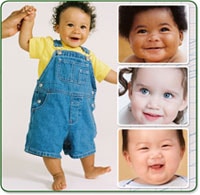WHO Growth Standards Are Recommended for Use with Children Younger Than Aged 2 Years in the United States

The Centers for Disease Control and Prevention (CDC) and the American Academy of Pediatrics (AAP) recommend that health care providers in primary care settings
- Use the WHO growth standard charts for children aged birth to younger than 2 years regardless of type of feeding, to monitor growth in the United States.1
- Use the CDC growth reference charts for children aged 2 until aged 20 years to monitor growth in the United States.1
Similar to the CDC growth reference charts, the WHO growth standard charts describe weight-for-age, length (or stature)-for-age, weight-for-length, and BMI-for-age. The WHO standards are relevant to infants and young children in the United States because they were included in the WHO study sample, and their growth tracks along the median of the pooled international sample.2-3
References
1Grummer-Strawn LM, Reinold C, Krebs NF; Centers for Disease Control and Prevention. Use of the World Health Organization and CDC growth charts for children aged 0-59 months in the United States. MMWR Recomm Rep. 2010;59(RR-9);1-15. https://www.cdc.gov/mmwr/preview/mmwrhtml/rr5909a1.htm. Accessed November 26, 2012.
2Dewey KG, Cohen RJ, Nommsen-Rivers LA, Heinig MJ; for the WHO Multicenter Growth Reference Study Group. Implementation for the WHO Multicentre Growth Reference Study in the United States. Food Nutr Bull. 2004;25(suppl 1):S84-S89.
3WHO Multicentre Growth Reference Study Group. Assessment of differences in linear growth among populations in the WHO Multicentre Growth Reference Study. Acta Paediatr. 2006;(suppl 450):56-65.